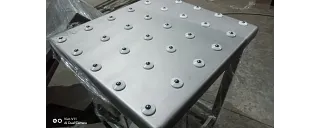Change Language :
Ball transfer units
Move heavy and sensitive loads easily: whether in conveyor technology, the food and glass industry or even in the sports sector. The transport of sensitive or heavy goods can be achieved with ball transfer units without great effort. Loads with a capacity of up to 1,470N can be carried without any problems, so that even heavy goods can be moved in almost all directions. The conveyor ball inside the housing is mounted with many small balls in order to ensure perfect running values. From pure plastic solutions to ball transfer units with a conveyor ball made of stainless steel: optimise work processes with our lubrication-free and low-maintenance ball transfer units for a wide range of applications.
Ball transfer unit options
How are the ball transfer units constructed?
xiros® ball transfer units have a housing made of high-performance plastics with an embedded ball socket. This pan serves as a running surface for the support balls. If the load ball rotates, the support balls roll on the ball socket. Depending on the application, various materials are available for the running ball and the support balls. The situation is completely different with the sliding ball transfer unit. The support balls previously used in our ball transfer units are replaced by a sliding insert made of the in-house iglidur® J3B. The stainless steel load ball therefore no longer runs on the support balls as in previous versions, but on the particularly wear-resistant sliding insert.

Application areas of ball transfer units
They are used in a wide range of industries and make it easier to move loads on flat surfaces. In the manufacturing industry, they are often used to transport heavy workpieces on assembly tables or in conveyor systems. They are also indispensable in the logistics sector as they simplify the transfer of goods to storage and sorting areas. Another area of application is mechanical engineering, where the ball transfer units are integrated into machine tables or packaging machines. They are also used not only in industry, but also in public facilities such as airports or shopping centres to make luggage or shopping carts easier to manoeuvre.
Frequently asked questions
Ball transfer units are components that enable the smooth movement of transported goods in various industrial environments in material handling. Transporting heavy loads from A to B: ball transfer units make it possible to transport food, airport goods or glass. Ball transfer units in conveyor tables make it easy to roll sensitive goods in various directions.
Depending on the application, they are made from different materials such as steel, stainless steel or plastic. At igus, we rely on tribologically optimised high-performance plastics.
Ball transfer units are used in a wide range of industries. In manufacturing, for example, they are used in conveyor systems, assembly lines and automated storage systems. Ball transfer units are also used in mechanical engineering to improve the manoeuvrability of machines and equipment. They are furthermore found in the furniture industry to make it easier to move heavy cabinets, tables and other pieces of furniture.
The housing protects the running ball and the balls inside the housing from dirt and dust, significantly extending the service life.
Contact us
Contact details

Seán Ryan086 0329555Submit form
Opening hours
Office hours
Monday to Friday from 8 am - 8 pm.
Live chat:
24h







